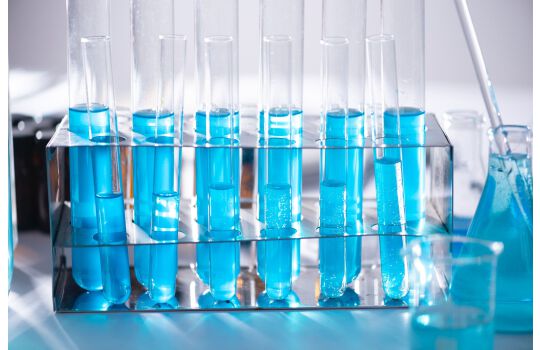Ethyl acetate (systematically ethyl ethanoate, commonly abbreviated EtOAc or EA) is the organic compound with the formula CH
3–COO–CH
2–CH
3, simplified to C
4H
8O
2. This colorless liquid has a characteristic sweet smell (similar to pear drops) and is used in glues, nail polish removers, decaffeinating tea and coffee. Ethyl acetate is the ester of ethanol and acetic acid; it is manufactured on a large scale for use as a solvent. The combined annual production in 1985 of Japan, North America, and Europe was about 400,000 tonnes.[4] In 2004, an estimated 1.3 million tonnes were produced worldwide.[5]
Production
Ethyl acetate is synthesized in industry mainly via the classic Fischer esterification reaction of ethanol and acetic acid. This mixture converts to the ester in about 65% yield at room temperature:
CH
3CH
2OH + CH
3COOH → CH
3COOCH
2CH
3 + H
2O
The reaction can be accelerated by acid catalysis and the equilibrium can be shifted to the right by removal of water. It is also prepared in industry using the Tishchenko reaction, by combining two equivalents of acetaldehyde in the presence of an alkoxide catalyst:
2 CH
3CHO → CH
3COOCH
2CH
3
Silicotungstic acid is used to manufacture ethyl acetate by the alkylation of acetic acid by ethylene:[6]
C
2H
4 + CH
3CO
2H → CH
3CO
2C
2H
5
By dehydrogenation of ethanol
A specialized industrial route entails the catalytic dehydrogenation of ethanol. This method is more cost effective than the esterification but is applied with surplus ethanol in a chemical plant. Typically, dehydrogenation is conducted with copper at an elevated temperature but below 250 °C. The copper may have its surface area increased by depositing it on zinc, promoting the growth of snowflake-like fractal structures (dendrites). Surface area can be again increased by deposition onto a zeolite, typically ZSM-5. Traces of rare-earth and alkali metals are beneficial to the process. Byproducts of the dehydrogenation include diethyl ether, which is thought to arise primarily due to aluminum sites in the catalyst, acetaldehyde and its aldol products, higher esters, and ketones. Separations of the byproducts are complicated by the fact that ethanol forms an azeotrope with water, as does ethyl acetate with ethanol and water, and methyl ethyl ketone (MEK, which forms from 2-butanol) with both ethanol and ethyl acetate. These azeotropes are broken by pressure swing distillation or membrane distillation.
Uses
Ethyl acetate is used primarily as a solvent and diluent, being favored because of its low cost, low toxicity, and agreeable odor. For example, it is commonly used to clean circuit boards and in some nail varnish removers (acetone and acetonitrile are also used). Coffee beans and tea leaves are decaffeinated with this solvent.[7] It is also used in paints as an activator or hardener.[citation needed] Ethyl acetate is present in confectionery, perfumes, and fruits. In perfumes, it evaporates quickly, leaving only the scent of the perfume on the skin.
Laboratory uses
In the laboratory, mixtures containing ethyl acetate are commonly used in column chromatography and extractions. Ethyl acetate is rarely selected as a reaction solvent because it is prone to hydrolysis and transesterification.
Ethyl acetate is fairly volatile at room temperature and has a boiling point of 77 °C (171 °F). Due to these properties, it can be removed from a sample by heating in a hot water bath and providing ventilation with compressed air.
Occurrence in wines
Ethyl acetate is the most common ester in wine, being the product of the most common volatile organic acid – acetic acid, and the ethyl alcohol generated during the fermentation. The aroma of ethyl acetate is most vivid in younger wines and contributes towards the general perception of "fruitiness" in the wine. Sensitivity varies, with most people having a perception threshold around 120 mg/L. Excessive amounts of ethyl acetate are considered a wine fault. Exposure to oxygen can exacerbate the fault due to the oxidation of ethanol to acetaldehyde, which leaves the wine with a sharp vinegar-like taste.[8]
Entomological killing agent
In the field of entomology, ethyl acetate is an effective asphyxiant for use in insect collecting and study. In a killing jar charged with ethyl acetate, the vapors will kill the collected insect quickly without destroying it. Because it is not hygroscopic, ethyl acetate also keeps the insect soft enough to allow proper mounting suitable for a collection.
Reactions
Ethyl acetate can be hydrolyzed in acidic or basic conditions to regain acetic acid and ethanol. The use of an acid catalyst accelerates the hydrolysis, which is subject to the Fischer equilibrium mentioned above. In the laboratory, and usually for illustrative purposes only, ethyl esters are typically hydrolyzed in a two-step process starting with a stoichiometric amount of a strong base, such as sodium hydroxide. This reaction gives ethanol and sodium acetate, which is unreactive toward ethanol:
CH
3CO
2C
2H
5 + NaOH → C
2H
5OH + CH
3CO
2Na
The rate constant is 0.111 L/mol·s at 25 °C.[citation needed


